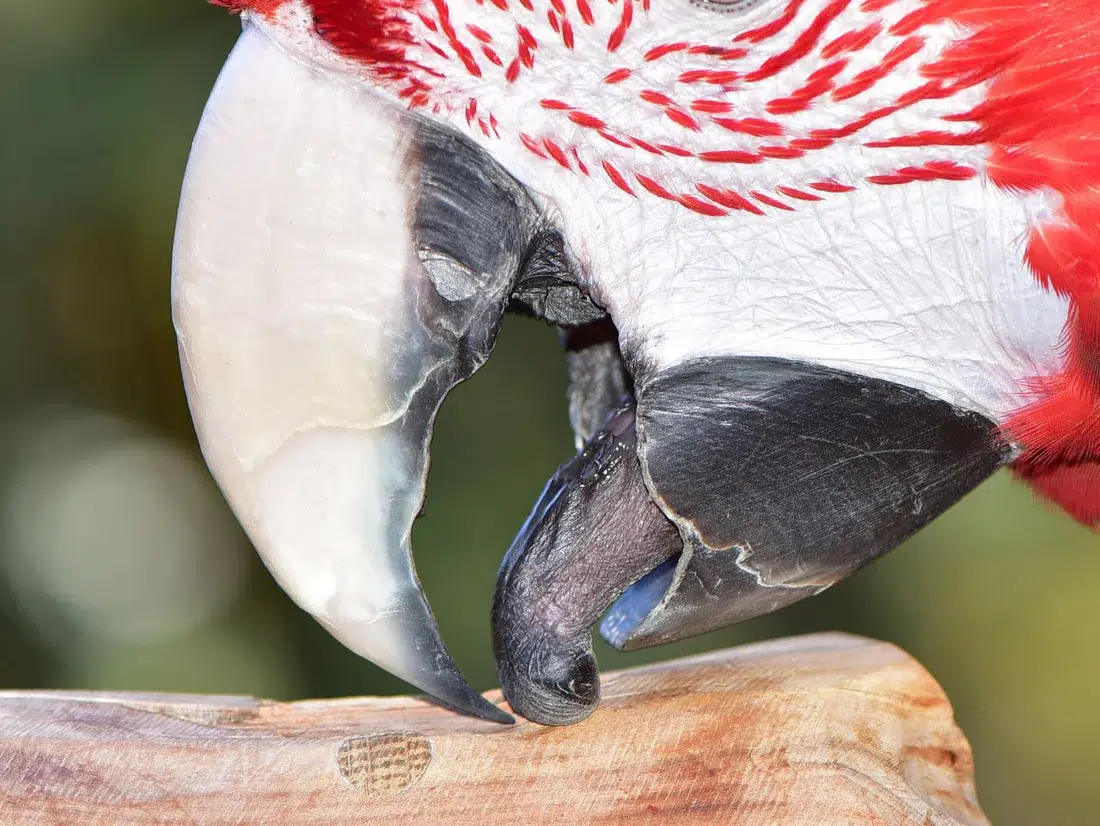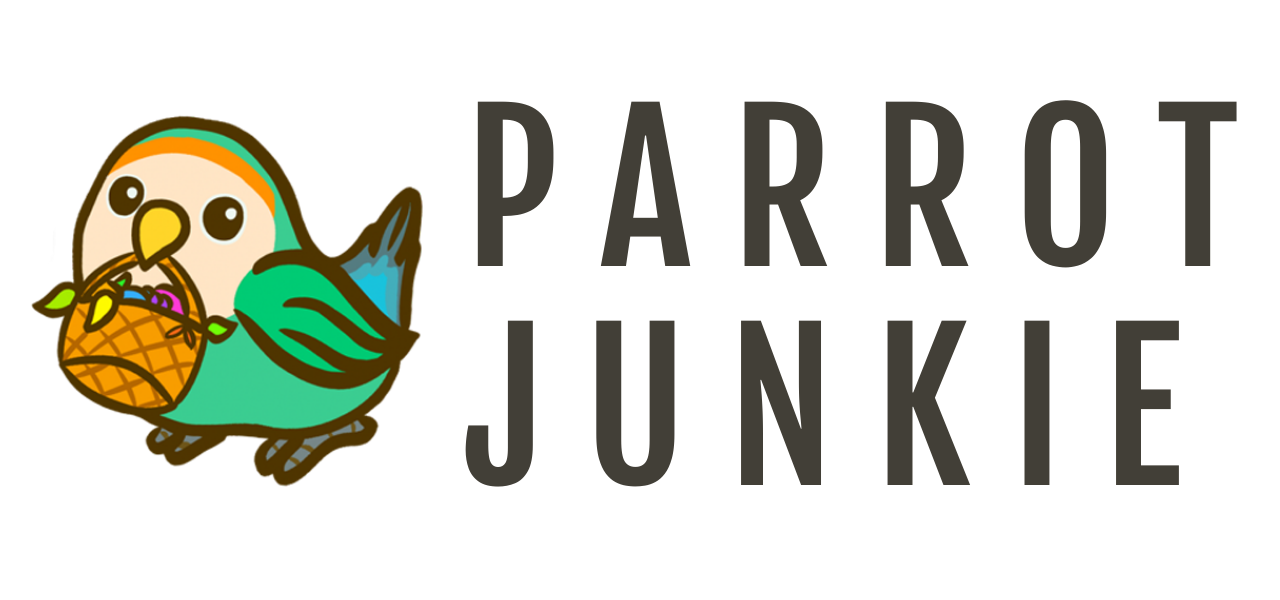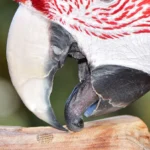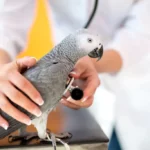
Parrot Beak Health Conditions – Overgrown, Scissor Beak, and more
A parrot relies heavily on its beak for many functions, including eating, climbing, feeling, positioning itself, feeding one another (and its young), preening feathers, and self defense. When a parrot has an issue with its beak, whether it is due to a birth defect, poor caretaking, trauma, or other health conditions, we will need to pay special attention and address the issue (ideally with the help of a vet) wherever possible.
Learn about some of the possible beak health conditions to look out for, and how to deal with them.
Jump To Section
Overgrown Beak
Overgrown beak is a common abnormality that can affect both the upper or lower beak. It can be caused by various reasons, including poor diet, poor health (such as liver issues), poor genetics (from improper breeding and husbandry), trauma to the beak, infections (such as sinus infections), etc.
Overgrown beaks require regular trimming and maintenance. However, you should never attempt to trim the beak yourself as this may lead to permanent disfigurement and bleeding. Some owners have tried to trim their bird’s beak with clippers only to have injured the bird severely or caused bleeding and pain.
Good beak grooming technique should not lead to bleeding or excessive pain (even if the bird may be quite uncomfortable during the session). Visit a vet or experienced groomer to handle the grooming as they would have proper grooming tools and are able to judge the right length of beak to trim.
Preventing and Managing Overgrown Beaks
To resolve or alleviate overgrown beak issues, consider the following:
- Offer a proper, balanced diet to your parrot
- Expose your parrot to sunlight regularly, to facilitate natural production of vitamin D3 (that cannot be otherwise obtained from food)
- Provide textured perches and surfaces for your bird to groom its beak on its own
- Consult with a vet to identify any possible underlying health issues that could have resulting in overgrown beaks
- Visit a groomer who is trained to groom birds, for regular beak maintenance
Avoid doing the following:
- Trimming the beak by yourself
- Trimming the beak using tools that are not adapted for beak trimming (e.g. nail clippers, etc.)
- Leave the overgrowing issue uncared for, as it can get worse and worse over time



Beak Trauma
Beak trauma is varied, and can range from minor to serious. Types of beak trauma include deep scratches, dents, cracks, or bruising. This can happen if the bird has collided with a hard surface, or rubbed its beak against a sharp object (causing a deep scratch). Some examples of possible accidents that may happen at home include:
- Flying into a hard surface (such as a window, mirror, door, or ceiling fan)
- Being unfamiliar with a new area and panicking, flying around uncontrollably, and banging into surfaces
- Getting caught in a door while the door is being closed
- “Spooking off” unexpectedly when being restrained, and the bird is being pulled back and hits its perch or another surface
- Fighting with another bird
- etc.
While not technically considered trauma, poor handling of baby birds can also lead to deformed beaks. For instance:
- Improper positioning and pressure of the feeding syringe can cause deformity on the chick’s beak
- Too much pressure when wiping the chick’s beak can also cause deformity
Preventing Beak Trauma
Accidents do happen and we should take precautions to prevent them:
- Consider placing curtains over mirrors to indicate that it is not an opening they can fly through.
- Self-adhesive frosted films on glass doors and windows can also help deter the bird from flying into glass.
- Introduce your bird around the house when it is calm. I have heard that allowing the bird to touch glass surfaces and mirrors gently with its beak helps inform the bird that the surface is impenetrable.
- Always check the location of your bird before closing doors. Some birds may try to fly to you while you are leaving the room, and squeeze through the door gap. Several birds have had severe injuries to the beak due to this happening.
- Close doors gently, don’t slam them (slamming doors can scare birds too, due to the loud sound).
- If your home is windy and doors swing shut by themselves due to the wind, use door stoppers that are strong enough to hold the door in place.
- If your birds do not get along and would fight, either supervise attentively when they are all out of their cages, or consider separating out-of-cage times for the different birds.
Even if the injury seems to be minor, beak trauma should not be taken lightly. Parrots are very alert and dexterous creatures, so they are not likely to be falling off a perch or bumping into a surface while flying, resulting in the beak trauma.
If this happens, your parrot might be feeling disorientated or having some underlying health issues that limits its coordination and spatial awareness. This warrants a visit to the vet for further diagnosis, particularly if you notice your bird banging into surfaces often.
Loss of Beak
When beak trauma is serious, it can result in the bird losing part of, or the entire mandible. Some accidents that cause loss of beaks include:
- Colliding hard into a surface, resulting in the beak being completely dislodged
- Fighting with another bird, resulting in the beak being torn off, such as the case with Sky the lovebird
- Being caught in a narrow gap such as when a door is closing shut, resulting in the beak shattering
In most of these cases, the beak would be completely and cleanly dislodged from its base, and the bird may bleed profusely. When this happens, it is important to contain the bird in a comfortable carrier and take it to an emergency vet right away, as every second can be crucial to the bird’s survival.
Parrots that have had their beaks detached but did not damage the base tissue may have a chance of the beak growing back. Mai the lovebird was one of such birds who managed to regrow part of the beak in three months after the trauma. The regrowth enabled him to eat almost normally now, but before that, the owner had to take care of his feeding very carefully. The story of how the accident happened can be found here.
In cases where birds do not manage to regrow the beak, the owner would have to ensure that the bird has access to liquid food (that does not require chewing) or that the bird is handfed if it is not able to lick the food on its own. In a worst case scenario, the bird might have to be humanely euthanized.
Preventing Loss of Beak
Loss of beak is mostly due to accidents occurring during daily life. To avoid your bird losing its beak, pay attention to environmental dangers such as:
- Ceiling fans and other moving parts – birds may get their beaks trapped or bumped against such places
- Closing or slamming doors – if you do not notice your bird perching on the door, it could get trapped
- Mirrors and other transparent surfaces – if your birds do not learn that there is a piece of glass there, place markings to indicate the presence of a surface, or condition your bird to recognize the surface by bringing it up close to the surface when the bird is calm
- Other birds – if your bird does not get along with other birds at home, do not force or allow interaction, as fights can often lead to severe outcomes
- Other types of pets – avoid letting your birds come into contact with other types of pets such as dogs, cats, and rabbits, as these animals can also injure your bird badly
Discolored Beak
Discoloration in beaks is most often caused by bruising, and bruising itself can have different causes.
If the parrot’s beak has suffered trauma as mentioned in the section above, the injury can cause bruising in the beak, resulting in a discolored beak. Trauma such as scratches and punctures can lead to infection below the beak, causing discoloration as well.
On the other hand, if the parrot has not been known to have suffered an injury to the beak, bruising may point to infections below the keratin sheath and further diagnosis will be needed.
Preventing Beak Discoloration
To prevent beak discoloration, refer to the above sections regarding beak trauma and beak loss, as the preventative measures are very similar.
Scissor Beak
Scissor beak (or crossed beak) is a beak that shows an improper alignment of the upper and lower mandibles. It could result from nutritional deficiencies, trauma, or genetics.

This lovebird has scissor beak and both mandibles have overgrown, resulting in difficulty in eating. Due to improper alignment, the bird may not have been able to groom its own beak properly, resulting in overgrowing. After grooming by an experienced groomer, the beak is in better shape, but the scissor condition could not be rectified. The bird is likely required to go for frequent grooming to maintain its beak shape and condition.
Preventing or Managing Scissor Beak
Treatment depends on the age of the bird. For younger birds, this could be corrected by applying gentle pressure on the beak a few times a day to align them back as the parrot grows up. For older parrots, veterinary help needs to be sought. Scissor beak is not necessarily fatal – if the bird is still able to eat and perform its daily functions, it may survive well after all.
However, pay attention if the bird is not able to eat well or groom well if it has a severe scissor beak condition. You may have to prepare food that is easier to eat, or even handfeed the bird for the long term if this happens.
Don’t give up on a bird with scissor beak! Milo the crooked birdie on Instagram proves that birds with scissor beak can still live a full and healthy life if cared for properly!
Beak Prognathism (Underbite)
In a typical beak alignment, the upper beak of parrots covers over the lower beak. Prognathism occurs when the tip of the upper beak rests within the lower beak, looking like an “underbite”, or as if the bird has a “protruding” lower beak. This condition can also be caused by various factors such as genetics or trauma.

Preventing or Managing Beak Prognathism
Just like scissor beaks, it may be rectified by applying gentle and appropriate pressure (guided by a vet) to ensure the top and lower beaks are aligned correctly, especially when the bird is still young. Some grooming can also help to rectify the condition, especially when it is not very serious.
Flaky or Peeling Beaks
As parrots use their beaks often, it is normal and common to observe lightly scratched (scruff marks) or flaky beaks. Beaks grow continuously like human hair or fingernails, and will have to be worn away. This is why parrots rub their beaks against surfaces to keep them groomed and functioning properly.
When a parrot has a flaky beak, it may be due to the normal wear and tear of daily use of the beak. However, in some cases, flaky beaks are due to poor diets and malnutrition, especially when observed with other physical conditions such as barred feathers or blunt choanal papillae.

Bibi’s beak was flaky, but other observable conditions such as feather condition and blunt choanal papillae showed me that his overall health was not great, which was very likely due to poor diet in his previous home. His beak also chipped and bled easily during the vet’s checkup. Now, it is so much better after more than a year of better diet including fresh fruits and vegetables, and pellets. He still gets flaky beak once in a while, but less severely than before.
Preventing Flaky or Peeling Beaks
The first thing you need to know when your parrot has flaky or peeling beaks, is to not attempt to break off the flakes, or file or sand it down, no matter how tempting it can be. If you are not aware of the overall beak health and strength of the sheath, you might end up causing further injury and infection to the parrot.
While flaky beaks can be a real eyesore, it does not usually hurt the parrot, unless the flaking is so bad that the beak starts to split open. Taking your bird to a vet or groomer would enable the bird’s condition to be assessed and further course of action to be taken to rectify the situation.
If the bird is determined to be in good health and has no serious beak issue, then the flakes could be due to regular wear and tear from chewing up toys in the cage.
Provide your bird with healthy, balanced meals to keep the beak in tip-top condition over the long term.
Illnesses and Infections
If a parrot has been ill, suffered a parasitic attack, an infection, or other kinds of issues on or around the beak, it can also lead to a deformed beak. The first image below shows a budgerigar infected with scaly mites, which resulting in overgrown beak and poor beak quality. Birds with Psittacine Beak and Feather Disease (PBFD) can also suffer beak deformities. Very often, this results in the parrot not being able to eat well, and eventually die due to poor health.

Preventing Beak Issues From Illnesses and Infections
Birds that are genetically predisposed to certain illnesses and infections may need extra care and support from the start, if they already exhibit signs of beak issues. PBFD, for example, can spread rapidly amongst a flock, and if you are aware of the health history of your bird, it can help you get prepared to face potential issues.
Other infections such as scaly mites can be treated with the help of medication, so early diagnosis and action by a vet will be beneficial, instead of waiting until the infection has progressed to the stage where it starts to affect the beak.
Daily observation of your birds and getting to know their behavior, as well as being able to spot signs of beak issues quickly may help you avoid a serious beak problem that becomes difficult to manage.
To Summarize…
A bird’s beak is a very important organ for survival and quality of life, so do pay attention to your birds’ beak health and any issues that may arise from accidents. Providing them the best care includes bird-proofing your home, having a qualified vet check on their health regularly, and giving them a balanced and varied diet can help prevent beak issues. For birds that already have beak issues upon birth, you will need to be prepared for additional care, especially if the bird is not able to eat on its own.
Bird care is not always easy, but hopefully, this article give you a good overview of possible beak conditions so that you can look out for them, and know what to do to deal with them!
Parrot Junkie www.parrotjunkie.com
Copyright © 2021-2024. All rights reserved.



Pingback:
Parrot Beak Anatomy - All You Need To Know (With Pictures!)
Retha Cumbie
17 August 2024
This is a fantastic guide.
Victor Mora
5 October 2024
Great article! I have one question if you might help me, i have an Indian Ringneck that i never seen move his upper peak, pretty much locked in. He is able to feed small things, but for example he is not able to take an almond with the front of his beak,, always from the side.
Parrot Junkie
12 October 2024
Hi Victor, thank you for dropping by. It’s hard to advise without looking at the exact situation of the bird’s beak, but I would encourage you to visit a vet to figure out if it is an injury, birth defect or other issue!
Jeannine Miesle
5 November 2024
That’s normal. Where the beak meets the cere, the upper beak (maxilla) is really attached and cannot move. Only the lower beak (mandible) can move.